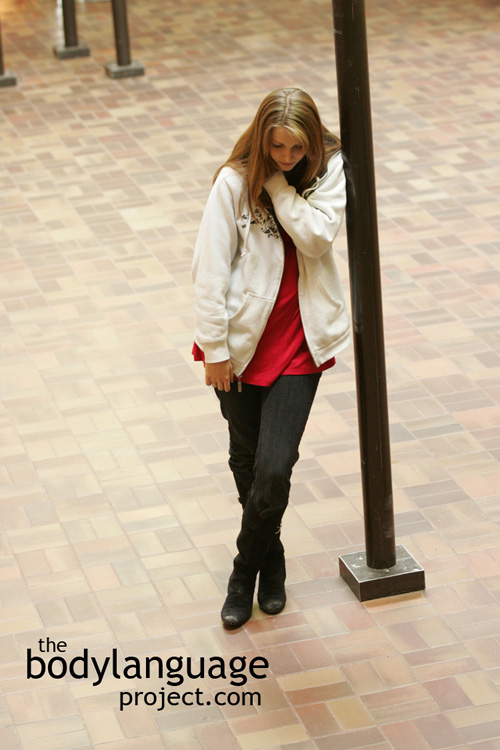Liars are difficult to detect and sometimes body language is more of a distraction than a help, however, most people still rely on visual cues and identify (at least in their mind) liars through their body language. While these cues are only sometimes useful in detecting lies, they are always valuable as cues to avoid if the desire is to appear honest and trustworthy in the eyes of others. In other words, here is a list of cues to avoid emitting yourself!
______________________________________________________________________________________________

Unnecessary face touching shows emotional discomfort. When in the right context, it can signal a lie.
Increased Face-Touching In Lying: Self touching is one thing we habitually associate with liars. Liars are thought to touch their chin, neck, nose, ears or will pull their collar away from their neck. These traits are of course related to nervousness and the mistake we sometimes make is directly associating nervousness with lying. Not all liars are nervous, some liars enjoy lying!
______________________________________________________________________________________________
The Ear Pull Body Language: The ear rub or pull is as gesture done as a response to greater blood flow to the ears and as a result of an increase in body temperature. Lying ear language can come in the form of a pull downward on the lobe, or as a scratch, or swipe behind the ear. When we get hot, we flush, and the neck and ears are particularly sensitive to flushing. Ears might be “blocked” in part when lying so as to avoid hearing our own fib. Only it is not a complete blocking, but rather an abbreviated blocking so instead of covering them completely, the hand merely grazes the ears or pulls on them. Pathological liars don’t hold a positive self image, at least not about their honesty and integrity therefore feel no remorse from telling a lie and therefore. This is why liars avoid the stress response lying usually produces.
______________________________________________________________________________________________
Neck Scratch And Collar Pull Body Language: When someone utters words such as “I completely agree with you, that sentiment is bang-on” but then punctuates the sentence with a neck scratch, it might mean that they in fact believe the opposite. Scratching the neck when no itch is present is a way to displace some of the nervous energy created by the lie and so distracts them from the pain of their dishonesty. Usually, honest neck scratching happens about five times, usually exactly. It seldom happens more than this, and rarely less. Thus, single scratches and excessive scratching can indicate underlying anxiety. The collar pull is another form of self touching that is related to the neck. In this case, the idea is to reduce friction causes by an increase in blood flow. As blood flow increases to our neck, it stimulates nerves which in turn cause irritation and discomfort. Other times, the collar pull is a way to release heat created by our bodies while under pressure due to higher levels of moisture from sweating.
______________________________________________________________________________________________

Hand-to-eye sometimes gives liars away as they wish to “see no evil” – in this case, the evil of their own lies.
Hand To Eye Gestures In Lying: Reaching for the eyes, rubbing the eyes or touching the skin below the eyes are all abbreviated forms of eye covering. It is a response to the embarrassment caused by the lie and is, in effect, an attempt to “see no evil.” As a response to seeing traumatic events we instinctively cover our eyes so as to shelter ourselves from negative images. This is a childhood throwback when kids would burry their face in blankets when confronted with scary scenes. However, in order not to give ourselves away, and to keep our victims in sight, adults stop short of covering their eyes completely, and instead only scratch just below the eyes. Men might vigorously rub their eyes however, whereas women will lightly rub around the eye so as not to smear their make-up.
______________________________________________________________________________________________

When a child lies, she might bring her hand up quickly and slap her mouth closed, but when an adult lies, she holds back and might only lightly touch the side of the mouth.
When a child lies, she might bring her hand up quickly and slap her mouth closed, but when an adult lies, she holds back and might only lightly touch the side of the mouth.
Hand To Mouth Gestures In Lying: Mouth covering is another way to reduce the pain of telling a lie. In this case, it is to “speak no evil.” Small children perform a full cover and even slap their mouths when they say something they shouldn’t. Grown adults will sometimes cup their hands to their mouth like children in effort to “jam the words back in” but usually use more subtle gestures such as talking through their hand or placing a finger softly over their lips.
______________________________________________________________________________________________

When people are stressed, blood flushes into the skin. Our hands are then drawn to the areas most affected due to increased sensitivity and heat so we tend to point out our stress. Enlarged capillaries in the nose can induce our hands in it’s direction to sooth it. As blood flows to the nose, it enlarges, giving credence to the ‘Pinocchio effect.’
Nose Language Of Liars: Nose touching might also stem from lying. It can happen as a quick but purposeful touch, the finger might graze the side of the nose, or it can be a persistent rubbing. Sometimes the touch is quick and dirty in an up and down motion, other times it is a brief almost unnoticeable touch to the base of the nose or its side. Face touching can come in two forms, one that serves a real function to alleviate an itch, and one that is the result of negative feelings such as being uncomfortable and stressed. Face touching that is due to an emotion is designed to fix the emotion-to sooth, and not due to any physical need.
______________________________________________________________________________________________

Closed body postures, like hands hiding in pockets, indicate insecurity which we subconsciously associate with lying.
Closed Body Postures In Lying: Closed body positions, as we know, give off bad signals in general. When in a high pressure situation, closing the body off in any way may cause people to think that you are dishonest. Tucking the chin in, pulling the arms closer to the body, crossing the legs, turning the body away, and taking on a less threatening profile are all attributed to lying. Another less obvious clue to being closed-off, is to subconsciously place an object between the liar and interrogator, such as a book, brief case, or any other “security-blanket.”
______________________________________________________________________________________________

Eyes that wont make contact or seem to dart around as if they are fabricating stories can give liars away.
Eye Patterns In Lying: Shifty eyes, where the eyes dart all over the room to focus on anything but someone else’s eyes, is habitually associated with lying. However, as we learned previously, most practiced liars hold gaze even more strongly than in normal situations. With regards to the general public who hold strong ideas about what a liar looks like, be sure to avoid gaze avoidance! Looking away for long periods of time, especially while talking, shifty eyes as mentioned, or using “stammering eyes”, which is the action of keeping the eyes closed for prolonged periods of time, have all been connected with lying. Under stress or arousal of any kind, the pupils expand so as to allow more light in. This can include stress and fear due to lying, or any other fearful situations for that matter, but does not discount the stimulus of seeing something particularly attractive, as this too causes pupil dilation.
______________________________________________________________________________________________



